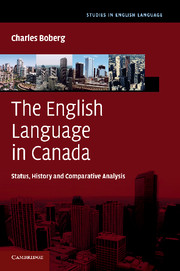Book contents
- Frontmatter
- Contents
- List of figures
- List of tables
- Acknowledgments
- Maps 1-3
- 1 English in the Canadian context
- 2 The establishment and growth of Canada's English-speaking population
- 3 The principal features of Canadian English in comparative perspective
- 4 Variation and change in the vocabulary of Canadian English
- 5 Variation and change in the phonetics of Canadian English
- 6 Summary and future directions
- References
- Index
4 - Variation and change in the vocabulary of Canadian English
Published online by Cambridge University Press: 05 August 2011
- Frontmatter
- Contents
- List of figures
- List of tables
- Acknowledgments
- Maps 1-3
- 1 English in the Canadian context
- 2 The establishment and growth of Canada's English-speaking population
- 3 The principal features of Canadian English in comparative perspective
- 4 Variation and change in the vocabulary of Canadian English
- 5 Variation and change in the phonetics of Canadian English
- 6 Summary and future directions
- References
- Index
Summary
In Chapter 3, the results of the North American Regional Vocabulary Survey (NARVS) were adduced to support the contention that, rather than being no more than a mixture of British and American words, the vocabulary of Canadian English features some uniquely Canadian words as well, even beyond the obvious category of words for things found only or mostly in Canada. For example, most Canadians say bachelor apartment, bank machine, grade one, runners or running shoes and washroom where most Britons say studio flat or bed-sit, cash dispenser, first form, trainers and loo and most Americans say studio apartment, ATM, first grade, sneakers and restroom; the Canadian terms, though referring to universal concepts, do not generally occur outside Canada. In this chapter, the NARVS data will again be referred to, in this instance to examine lexical variables that display regional differences within Canadian English, more than national differences between Canadian English and other dialects. Correlations between NARVS data and respondents' ages will also be analyzed in order to identify lexical changes in progress in Canadian English, measured in terms of apparent-time. A complementary view of change in real-time will be developed by comparing the NARVS data to data from earlier surveys.
The North American Regional Vocabulary Survey (NARVS)
Before turning to the NARVS data, however, some background information will be offered on the methods employed in their collection and analysis.
- Type
- Chapter
- Information
- The English Language in CanadaStatus, History and Comparative Analysis, pp. 167 - 198Publisher: Cambridge University PressPrint publication year: 2010



